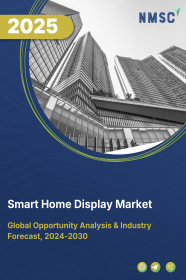
Asia-Pacific Smart Display Market by Display Technology (LCD, LED, E-Paper Display, and Other Display Technologies), by Type (Standalone Smart Displays, Integrated Smart Displays, Interactive Touchscreen Displays, Transparent Smart Displays, and Other Display Types), by Display Size (Below 24 Inch, 24 Inch to 55 Inch, and Above 55 Inch), by Resolution (UHD, FHD, HD, and Others) and Others– Opportunity Analysis and Industry Forecast, 2023–2030
Industry: Semiconductor & Electronics | Publish Date: 14-Feb-2025 | No of Pages: 157 | No. of Tables: 124 | No. of Figures: 87 | Format: PDF | Report Code : SE1036
US Tariff Impact on Asia-Pacific Smart Display Market
Trump Tariffs Are Reshaping Global Business
Market Definition
Asia-Pacific Smart Display Market was valued at USD 5.26 billion in 2022, and is predicted to reach USD 19.92 billion by 2030, with a CAGR of 16.5% from 2023 to 2030. A smart display is a sophisticated device featuring a touchscreen or interactive visual interface, coupled with voice recognition and artificial intelligence capabilities.
Functioning as versatile information hubs, these displays can execute diverse tasks, including presenting information and managing smart home devices. They offer visual responses to voice commands, facilitating video calls and serving as interactive tools for scheduling, weather updates, and entertainment purposes.
Smart displays are meticulously crafted to elevate convenience, accessibility, and user engagement across various settings, such as homes, offices, and public spaces. Their applications span residential homes, offices, healthcare facilities, retail, education, and beyond.
Asia-Pacific's Dynamic Influence: Key Trends Fueling a Smart Display Revolution Across Industries and Homes
In the Asia-Pacific region, pivotal trends are shaping the smart display industry. The dominant position in electronics exports, coupled with the rapid expansion of the automotive market, is fueling the demand for smart displays. A tech-savvy population is driving a surge in the adoption of smart home devices, with a particular emphasis on integrating smart displays with IoT devices.
The flourishing electronics industries and the increasing demand for electronic devices, including smart displays, are poised to have a significant impact on the global economy. Government-led tech initiatives, alongside innovations from global tech leaders, are propelling the smart display industry forward.
Elevating Urban Living: The Driving Forces Behind the Smart Display Surge in the Asia-Pacific Region
Rapid urbanization and a growing population are creating substantial demand for smart display technology. Technological advancements and government focus on smart cities are fueling innovation and adoption of smart displays. Finally, a robust IT infrastructure and high-speed internet availability are driving the demand for seamless digital interactions through smart displays. These regional dynamics collectively contribute to the evolving landscape of the smart display industry in the Asia-Pacific region.
Security Vulnerabilities in Smart Home Displays Restrain Market Growth
Security vulnerabilities in smart display technology represent a significant restraining factor for the smart display market. The potential for security breaches in smart displays poses a substantial risk to users. Insufficient security measures, such as weak passwords and inadequate encryption, could lead to the exposure of sensitive data. Therefore, it is imperative for manufacturers to prioritize robust security features within smart displays, including strong authentication methods and prompt vulnerability patching through regular updates.
Introduction of Laser-Based Display Technology
Laser-based display technology is presenting substantial opportunities within the smart display market. Its exceptional brightness, color accuracy, long-lasting durability, and energy efficiency position it as a prime choice for diverse applications, spanning from home theaters to outdoor signage and augmented reality experiences. The extended lifespan and reliability of laser-based displays result in reduced maintenance costs and align with sustainability objectives.
As this technology becomes increasingly accessible and cost-effective, it is instigating innovation in the realm of smart displays, particularly in sectors where top-tier visual quality and energy conservation are paramount, thus broadening the market's potential for expansion.
The China Holds the Dominant Market Share in the Asia-Pacific Market
China's global dominance in electronics exports is expected to continue in the foreseeable future, thanks to its massive manufacturing capacity and low labor costs. In 2021, China exported USD 671.5 billion in electronics, accounting for 27.4% of the global market. This unparalleled dominance is also evident in the smart display industry, where China accounts for over 60% of global market share.
Chinese companies are producing a wide range of smart displays at different price points, making them more affordable for a wider range of consumers. They are also investing heavily in research and development to develop new technologies and products.
Indonesia is Expected to Show Steady Growth in the Asia-Pacific Smart Display Market
The growth of the smart display market is being propelled by a collective effort from various market players who are actively adopting strategies to create innovative products featuring technological advancements in digital signage and interactive billboards.
For instance, Hisense, a prominent Chinese electronics manufacturer, collaborated with V2 Indonesia in March 2022 to develop the latest model of an interactive whiteboard or commonly known as an interactive digital board (IDB). This also intends to expand the collaboration between the two companies to market a digital signage line with the ability to turn on 24 hours a day.
Competitive Landscape
The Asia-Pacific smart display industry includes several market players such as Samsung Electronics, Qisda Corporation (BenQ), LG Corporation, Sharp Corporation, Lenovo Group Limited, Alps Alpine Co., Ltd, Sony Corporation, Google, LLC., Leyard Optoelectronic Co., and Amazon.com, Inc.
Key Benefits
-
The Asia-Pacific smart display market report provides a quantitative analysis of the current market and estimations through 2023-2030 that assists in identifying the prevailing market opportunities to capitalize on.
-
The study comprises a deep dive analysis of the market trend including the current and future trends for depicting the prevalent investment pockets in the market.
-
The information related to key drivers, restraints, and opportunities and their impact on the market is provided in the report.
-
The competitive analysis of the market players along with their market share in the Asia-Pacific smart display market.
-
The SWOT analysis and Porter’s Five Forces model are elaborated in the study.
-
Value chain analysis in the market study provides a clear picture of the stakeholders’ roles.
Asia-Pacific Smart Display Market Key Segments
By Display Technology
-
LCD
-
LED
-
E-Paper Displays
-
Other Display Technologies
By Type
-
Standalone Smart Displays
-
Integrated Smart Displays
-
Interactive Touchscreen Displays
-
Transparent Smart Displays
-
Other Display Types
By Display Size
-
Below 24 inch
-
24 inch to 55 inch
-
Above 55 inch
By Resolution
-
UHD
-
FHD
-
HD
-
Others
By Sales Channel
-
Direct Sales
-
Retailers and Distributors
-
E-Commerce Or Online Sales
By Application
-
Smart Home
-
Digital Signage
-
Automotive
-
Healthcare
-
Other Applications
By Geography
-
Asia-Pacific
-
China
-
Japan
-
India
-
South Korea
-
Australia
-
Indonesia
-
Singapore
-
Taiwan
-
Thailand
-
Rest of Asia-Pacific
-
REPORT SCOPE AND SEGMENTATION:
|
Parameters |
Details |
|
Market Size in 2022 |
USD 5.26 Billion |
|
Revenue Forecast in 2030 |
USD 19.92 Billion |
|
Growth Rate |
CAGR of 16.5% from 2023 to 2030 |
|
Analysis Period |
2022–2030 |
|
Base Year Considered |
2022 |
|
Forecast Period |
2023–2030 |
|
Market Size Estimation |
Billion (USD) |
|
Growth Factors |
The growing tech-savvy population The rapid urbanization. |
|
Countries Covered |
9 |
|
Companies Profiled |
10 |
|
Market Share |
Available for 10 companies |
|
Customization Scope |
Free customization (equivalent up to 80 working hours of analysts) after purchase. Addition or alteration to country, regional, and segment scope. |
|
Pricing and Purchase Options |
Avail customized purchase options to meet your exact research needs. |
KEY PLAYERS
-
Samsung Electronics
-
Qisda Corporation (BenQ)
-
LG Corporation
-
Sharp Corporation
-
Lenovo Group Limited
-
Alps Alpine Co., LTD
-
Sony Corporation
-
Google, LLC.
-
Leyard Optoelectronic Co
-
Amazon.com, Inc.

















 Speak to Our Analyst
Speak to Our Analyst



















